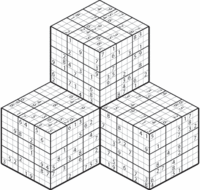Picross vs. Sudoku & The Power of Forms
 Wednesday, March 11, 2009 at 9:26PM
Wednesday, March 11, 2009 at 9:26PM The following article is a structural comparison between two DS puzzles games: Sudoku, I recommend either Brain Age versions, and Picross DS.

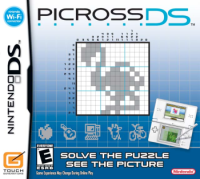
Both of these games are designed around a grid where players must mark the squares in specific ways. In Sudoku, the squares are filled with one number each. And in Picross each square is either filled in or left blank.
Each challenge is a puzzle that players must solve by understanding the intricacies of the coding system. The codes in these games are made up of a few rules.
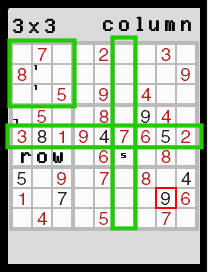

Sudoku (image left): Each row, column, and box must only contain the numbers 1-9 without any duplicates. Play it here.
Picross (image right): Each column/row must contain filled in squares in the groupings specified by the string of numbers posted to the top/left of the grid. Each grouping must be separated from each other mark by at least one empty square. Play it here.
With just a bit of data provided by the coding system for type of puzzle, the player is able to, through the process of deduction, figure out each square on the grid. By filling in part of the grid, the range of possibilities decreases for the remaining squares on the grid. This process continues until the grid is complete.
At this point, I wanted to state that both of these puzzle systems are very solidly designed. In my puzzle game experience, I've found that the simpler the puzzle system, the better the puzzle game. For it's more impressive if one can design many puzzles with a wide range of difficulty using a puzzle system that's very simple. So at this point, I want to consider the complexity and flexibility of the Sudoku and Picross systems.
Complexity
Each Sudoku square potentially contains 1 of 9 numbers. With more difficult puzzles, a good strategy is to write down the possible numbers of a square in tiny print so you can help yourself narrow down the answer. Every square in Picross is much simpler. To solve Picross puzzle, each square must be marked or left unmarked. Similar to Sudoku, a good strategy in Picross is to mark all the known unmarked squares with an "x." In this way, a blank Picross square is potentially 1 of 2 states.
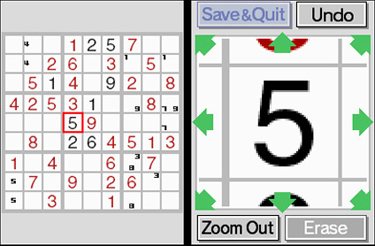
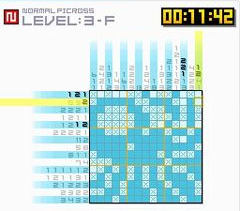
Though Sudoku has a wider range (more complex) for its input system, the design trade off is a simple presentation of the code data. In Sudoku, each puzzle challenge presents a few numbers up front. These numbers are the code that players use to solve the puzzle (see red numbers in image above-left). Just a few numbers scattered here and there does the trick. The opposite is true for Picross. The more complicated the image and the more difficult the puzzle, the more complex the code is along the top and left side of the puzzle (see image above-right). For these two puzzles games, the relationship between their code complexity and their input complexity is an inverse relationship that reflects the nature of puzzle game systems that are designed around deduction. In other words, to create a decent challenge, there must be enough possible answers, solutions, moves, or inputs at the outset to conceal or distract the only solution so that players have to slowly work at the puzzle using what little they can uncover to start a puzzle solving chain reaction.
Flexibility
Sudoku is a game that works around the number 9. The grid is 9x9. Each of the 9 rows, columns, and 3x3 grids must only contain the numbers 1-9 without repeating a number. Each puzzle challenges players to fill in the right numbers. But after the puzzle is solved, players are left with a grid of numbers. This ultimately describes all Sudoku games in the Brain Age DS games. Sure there are many variations on Sudoku out there. But these variants require additional rules. The system that I have in my Brain is is what I'm stuck with. In this way, the Sudoku puzzle design is not very flexible.
On the other hand, the few rules of Picross are not bound to a particular grid size. Picross puzzles can be 5x5, 10x10, and 15x15. In addition to the flexible size of Picross puzzles, there is one key difference that wins the puzzle game war between the two games. That difference is forms.
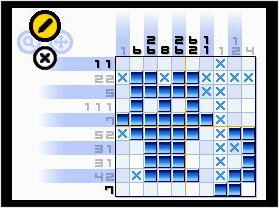
It doesn't matter how pixelated the pictures are or how simple they appear. Every mark you make solving a Picross puzzle, you're actually creating a picture. In a very paint by numbers fashion, with a little methodical persistence, anyone can become an "artist." Going from a blank grid and slowly etching out an image is like pressing your face up against one of those magic 3D images. All of a sudden, you see a shape that wasn't there before. It's like art. It's like magic. And it's these forms that help give every Picross puzzle interesting layers that appeal to multiple senses/types of accomplishment and satisfaction.
If you ever find yourself in a position where you want to make a guess in either game, guessing in Sudoku is like putting down a random answer on a match quiz. Guessing in Picross is a little less random and abstract. If you can visualize the image behind the puzzle that you're solving in Picross, it's possible to make educated guesses in based on the image. Can you fill in the missing squares in the cat above. I bet you can get close.
On top of all of this, the forms also give every player the power to create their own puzzles. Using the DS touch screen, simply draw a picture over a blank grid and the computer system will make sure your artwork is playable. There would be no point to creating your own Sudoku puzzles. They're all just numbers anyway.
In conclusion, Picross is a puzzle game that turns gamers into code crackers, artists, and puzzle makers. The code system is no more complicated than a bit of addition and subtraction, yet the forms are what separate Picross from Sudoku. It's amazing what a little form can do to a video game. I don't wonder what the next level is for these two puzzles systems. What's done in 2D can always go...


